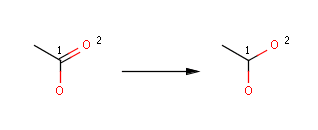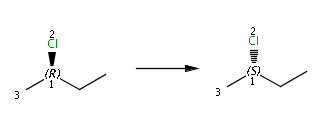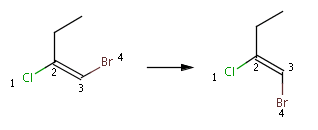Reaction Mapping
Atom mapping in the reaction equation serves for identifying atoms on the reactant and product sides. An atom having different neighboring atoms, attached bonds, chirality on the reactant and the product sides should be flagged on both sides.
In any case, changing atoms should be mapped for Reactor. A reaction atom is called changing in any of the following cases:
-
it is an orphan atom (an atom appearing only one side of the reaction arrow)
-
it has different atomic properties (e.g. charge) in the reactant and the product sides
-
any of its attached bonds is changed, created or deleted in the reaction
-
it is a stereo center (if retention or inversion is defined by wedges then at least all but one neighboring non-hydrogen atoms should also be mapped)
-
it is a member of a changing double bond stereoatom quartet
Atoms having changing bonds are marked by so-called map numbers on both sides of the reaction arrow. Map numbers should follow the following conventions:
-
the corresponding atoms on the two sides of the reaction arrow are identified by the same map number,
-
atom maps cannot be duplicated on one side
-
When a map number appears only on one side of the reaction scheme, it marks an orphan atom. An orphan atom on the reactant side is removed, an orphan atom on the product side is added during the reaction.
Examples:
|
changing bond type |
|
|
orphan atoms |
|
|
chirality |
|
|
double bond stereo |
|
Reaction mapping follows the unmapped atoms that are not changed in the reaction - they exist on both sides and have the same neighborhood with the same attaching bond types on both sides. Mapping more atoms than necessary (possibly all atoms) makes no harm but increases processing time a little bit.
By default Reactor checks whether all changing atoms of the reaction are mapped, and if not, then maps all atoms (original atom maps are preserved, only unmapped atoms will be mapped). This check can be ignored if required.



